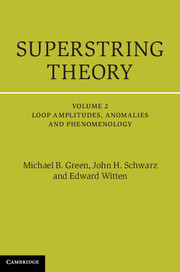79 results
Preface to the 25th Anniversary Edition
-
- Book:
- Superstring Theory
- Published online:
- 05 September 2012
- Print publication:
- 26 July 2012, pp xi-xii
-
- Chapter
- Export citation
13 - Low-energy effective action
-
- Book:
- Superstring Theory
- Published online:
- 05 September 2012
- Print publication:
- 26 July 2012, pp 307-362
-
- Chapter
- Export citation
Frontmatter
-
- Book:
- Superstring Theory
- Published online:
- 05 September 2012
- Print publication:
- 26 July 2012, pp i-iv
-
- Chapter
- Export citation
12 - Some differential geometry
-
- Book:
- Superstring Theory
- Published online:
- 05 September 2012
- Print publication:
- 26 July 2012, pp 271-306
-
- Chapter
- Export citation
3 - Modern covariant quantization
-
- Book:
- Superstring Theory
- Published online:
- 05 September 2012
- Print publication:
- 26 July 2012, pp 121-184
-
- Chapter
- Export citation
References
-
- Book:
- Superstring Theory
- Published online:
- 05 September 2012
- Print publication:
- 26 July 2012, pp 562-585
-
- Chapter
- Export citation
Bibliography
-
- Book:
- Superstring Theory
- Published online:
- 05 September 2012
- Print publication:
- 26 July 2012, pp 435-464
-
- Chapter
- Export citation
Bibliography
-
- Book:
- Superstring Theory
- Published online:
- 05 September 2012
- Print publication:
- 26 July 2012, pp 553-561
-
- Chapter
- Export citation
14 - Compactification of higher dimensions
-
- Book:
- Superstring Theory
- Published online:
- 05 September 2012
- Print publication:
- 26 July 2012, pp 363-412
-
- Chapter
- Export citation
String Field Theory
-
- Book:
- Superstring Theory
- Published online:
- 05 September 2012
- Print publication:
- 26 July 2012, pp 586-590
-
- Chapter
- Export citation
8 - One-loop diagrams in the bosonic string theory
-
- Book:
- Superstring Theory
- Published online:
- 05 September 2012
- Print publication:
- 26 July 2012, pp 1-74
-
- Chapter
- Export citation

Superstring Theory
- 25th Anniversary Edition
-
- Published online:
- 05 September 2012
- Print publication:
- 26 July 2012
Frontmatter
-
- Book:
- Superstring Theory
- Published online:
- 05 September 2012
- Print publication:
- 26 July 2012, pp i-iv
-
- Chapter
- Export citation
1 - Introduction
-
- Book:
- Superstring Theory
- Published online:
- 05 September 2012
- Print publication:
- 26 July 2012, pp 1-56
-
- Chapter
- Export citation
15 - Some algebraic geometry
-
- Book:
- Superstring Theory
- Published online:
- 05 September 2012
- Print publication:
- 26 July 2012, pp 413-474
-
- Chapter
- Export citation
Index
-
- Book:
- Superstring Theory
- Published online:
- 05 September 2012
- Print publication:
- 26 July 2012, pp 591-596
-
- Chapter
- Export citation
16 - Models of low-energy supersymmetry
-
- Book:
- Superstring Theory
- Published online:
- 05 September 2012
- Print publication:
- 26 July 2012, pp 475-552
-
- Chapter
- Export citation
9 - One-loop diagrams in superstring theory
-
- Book:
- Superstring Theory
- Published online:
- 05 September 2012
- Print publication:
- 26 July 2012, pp 75-140
-
- Chapter
- Export citation
2 - Free bosonic strings
-
- Book:
- Superstring Theory
- Published online:
- 05 September 2012
- Print publication:
- 26 July 2012, pp 57-120
-
- Chapter
- Export citation
6 - Nonabelian gauge symmetry
-
- Book:
- Superstring Theory
- Published online:
- 05 September 2012
- Print publication:
- 26 July 2012, pp 291-352
-
- Chapter
- Export citation

